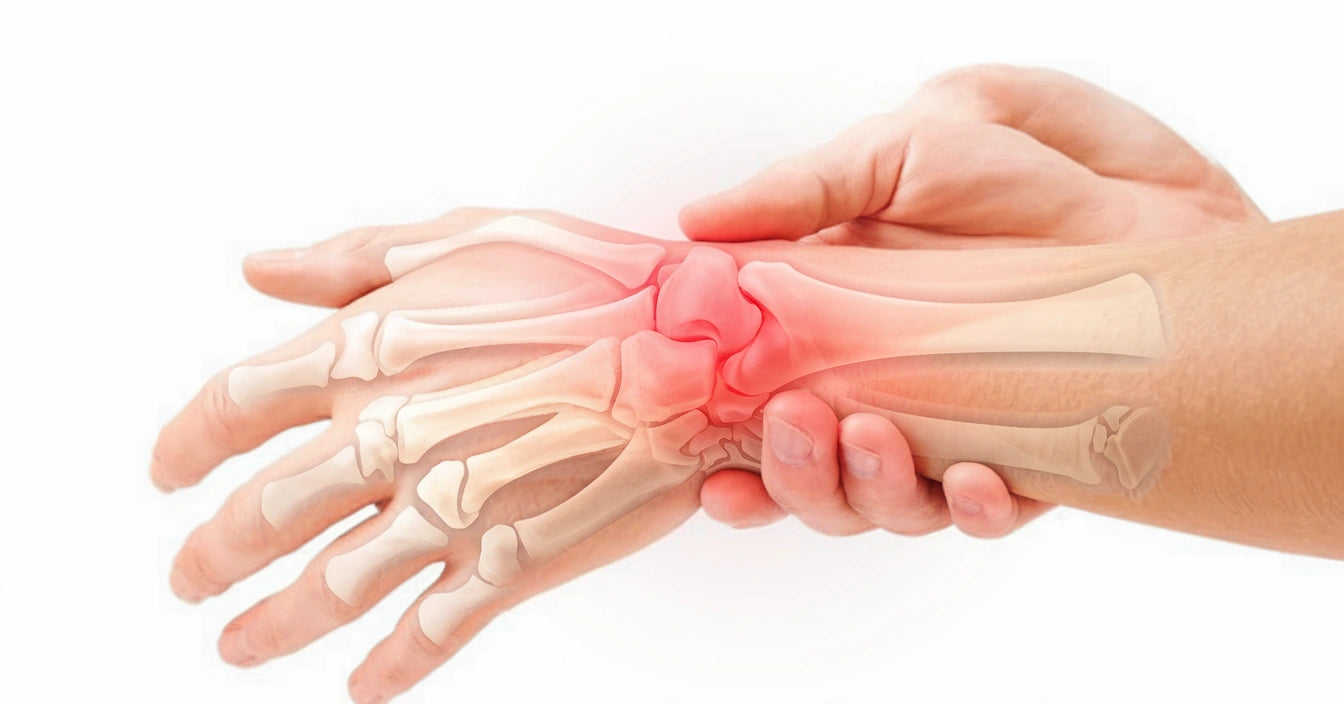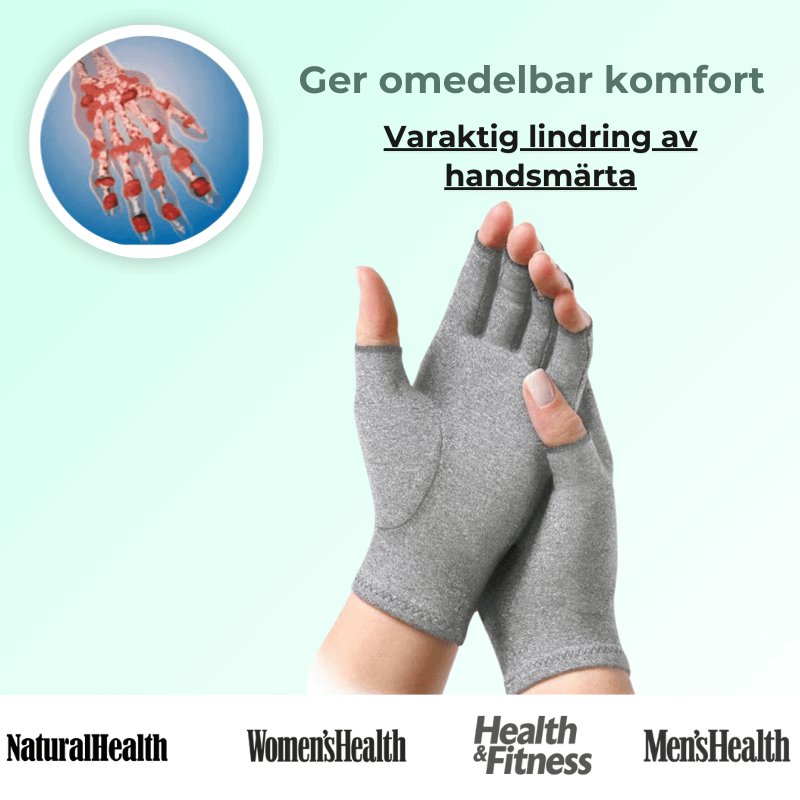Reumatisk sykdom i hender og føtter: Symptomer, årsaker og behandling

Rheumatoid arthritis, or rheumatoid arthritis, is a chronic inflammatory disease that affects the joints, often in the hands and feet. The disease can lead to pain, stiffness, and swelling, which affects quality of life. In this article, we will review the most common symptoms, causes, and treatment options for rheumatism in the hands and feet.
Definition and background: What is rheumatism of the hands and feet (RA and rheumatoid arthritis)?
Rheumatoid arthritis of the hands and feet is an inflammatory joint disease that causes pain, swelling, and stiffness in the joints. The condition can affect mobility and quality of life. Treatment includes medication, physical therapy, and lifestyle changes.
Rheumatoid arthritis (RA) is a systemic autoimmune disease that is distinct from osteoarthritis ( rheumatism in the knee symptoms ). While osteoarthritis primarily affects the cartilage in the joints, rheumatism attacks the synovium, which becomes inflamed. Rheumatic diseases are a group of several conditions, with rheumatoid arthritis being one of the most common forms, often affecting the hands and feet.
Symptoms and signs: Swollen joints, stiffness, and pain in the hands and feet
Rheumatism often begins insidiously with symptoms that can vary between individuals. Common symptoms include:
- Joint pain: The pain is often symmetrical, meaning that both the right and left hand or foot are affected at the same time. The pain can be dull or sharp.
- Swelling: The joints may swell and feel tender to the touch or movement.
- Stiffness: Morning stiffness is a common symptom and can be particularly pronounced in the fingers and toes. The stiffness can last for several hours.
- Warmth: The joints may feel warm to the touch due to inflammation.
- Deformities: With long-term rheumatism, the joints can become deformed, for example crooked fingers or toes.
- Fatigue: The effects of inflammation on the body can lead to general fatigue and malaise.
- In children with rheumatism, symptoms may be more difficult to identify but often include stiffness and reluctance to use the affected joints.
How does rheumatism in the hands start? Usually with swollen, stiff and painful joints, especially in the knuckles and the middle joints of the fingers. Many people find that the symptoms worsen in the cold. Rheumatism in the hands symptoms can also mean that you lose strength in your hands and have difficulty performing fine motor tasks. Signs of rheumatism in the feet include swelling, pain and stiffness, especially in the toes and forefoot. Pain in the feet with rheumatism is often worst in the morning or after longer periods of inactivity.
Causes and risk factors: Why do people get rheumatism and who is at greater risk?
Rheumatism is an autoimmune disease in which the body's immune system attacks its own tissue, including the joints. The exact causes are not fully known, but several factors may contribute:
- Genetic factors: Heredity plays a role in the development of rheumatism.
- Infections: Some infections can trigger the immune system to attack the body's own tissues.
- Lifestyle factors: Smoking has been shown to increase the risk of developing rheumatism.
- Hormonal factors: Women are at greater risk than men of developing rheumatism, suggesting a hormonal link.
Rheumatism can affect multiple joints at the same time, and the intensity of the symptoms can vary from person to person. The inflammation can also affect other parts of the body in addition to the joints, including muscles and tendons. For some, rheumatic symptoms can include tingling in the fingers and feet , which can be confused with other conditions.
Diagnosis and treatment of rheumatism
Rheumatism encompasses several diseases that affect joints, muscles, and tendons—often resulting in pain, swelling, and stiffness. Early diagnosis is crucial to slowing the progression of the disease and preserving mobility. Treatment usually consists of a combination of medication, physical therapy, heat treatment, and ergonomic aids.
Medication
Anti-inflammatory or biological drugs are used to reduce inflammation and slow down the progression of the disease.
BambuFlex gloves complement medical treatment by reducing stiffness and discomfort in the hands.
Physical therapy
Regular movement exercises help maintain strength and mobility in the joints.
FotSupporten provides support during exercise and rehabilitation by relieving pressure on the joints in the feet and ankles.
Ergonomic aids
Customized shoes, wrist supports, or orthotics can reduce stress on the joints and improve everyday movements.
BambuFlex gloves and FotSupporten provide stability and comfort during daily activities.
Heat treatment
Heat increases blood circulation, relieves stiffness, and reduces pain in inflamed areas.
Termoreliever™ offers targeted heat therapy for hands, feet, and joints, which can relieve symptoms without medication.
Diagnosis and follow-up
The diagnosis is made by a rheumatologist through a combination of clinical examination, blood tests, and imaging diagnostics.
Regular check-ups are important to monitor progress and adjust treatment as needed. A personalized exercise program can be designed to strengthen the muscles around the joints and prevent misalignment.

Support for rheumatism: How BambuFlex gloves, FotSupporten and Termoreliever™ improve treatment
These products offer several benefits for people suffering from rheumatism in the hands and feet:
- BambuFlex gloves: Provides support and warmth to sore joints in the hands. Bamboo fiber has natural heat-regulating properties that relieve stiffness and improve blood circulation.
- Foot Support : Relieves pressure on the feet by providing support to the arch of the foot. This reduces pain during walking and standing activities.
- Termoreliever™: Provides targeted heat therapy to help relieve stiffness and pain in both hands and feet. Can be used during rest or activity.
The combination of these products contributes to increased comfort, improved mobility and reduced pain during everyday life. For people with rheumatism in the hands who are particularly sensitive to cold, the BambuFlex gloves can provide significant relief by keeping the joints warm. In case of pain in the feet due to rheumatism, the FootSupport can reduce the load on the inflamed joints and thus relieve the pain.
Conclusion
Rheumatism in the hands and feet is a chronic disease that requires long-term management. Through a combination of medical treatment, lifestyle changes and the use of supportive aids such as BambuFlex gloves, FotSupporten and Termoreliever™, many people can effectively manage their symptoms. It is important to seek care early to slow the progression of the disease and preserve joint function. Many can live an active life with the right treatment and support, despite the disease being chronic.
Early anti-rheumatic treatment is crucial to prevent permanent joint damage. With today's modern drugs and rheumatological care, the prognosis for people with rheumatism has improved significantly. Many can live active lives with the right treatment and support, despite the disease being chronic.
Frequently Asked Questions (FAQ)
How does rheumatism in the hands start?
Rheumatism often begins with insidious symptoms such as morning stiffness, sore joints, and swelling in the fingers or wrists.
Can children get rheumatism?
Yes, children can suffer from juvenile idiopathic arthritis (JIA), a form of inflammatory joint disease similar to adult rheumatoid arthritis.
How do I relieve morning stiffness from rheumatism?
Heat therapy with Termoreliever™, light stretching, or a warm bath can help reduce morning stiffness.
Can BambuFlex gloves be used all day?
Yes, the gloves are designed for long-term use during both rest and activity to provide continuous support.
When should I seek treatment for suspected rheumatism?
If you experience persistent pain, swelling, or stiffness in your joints, you should see a doctor for evaluation as soon as possible. Early diagnosis is crucial for effective treatment.

